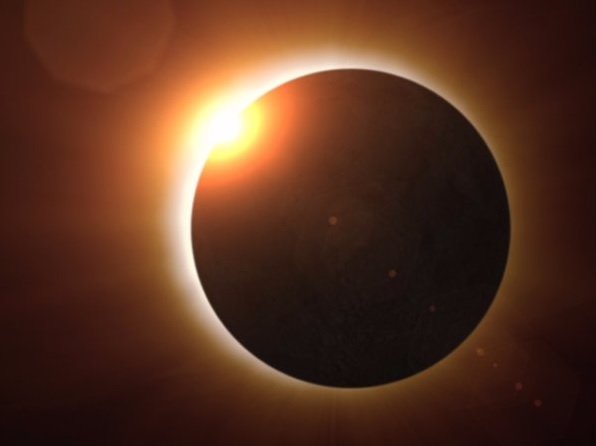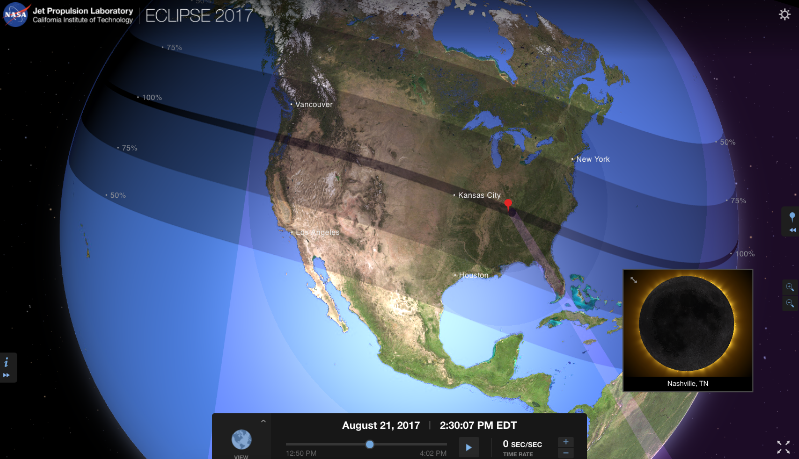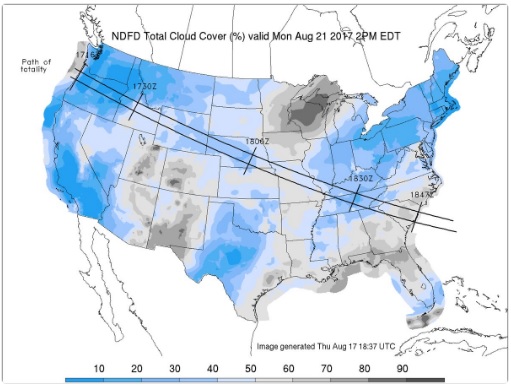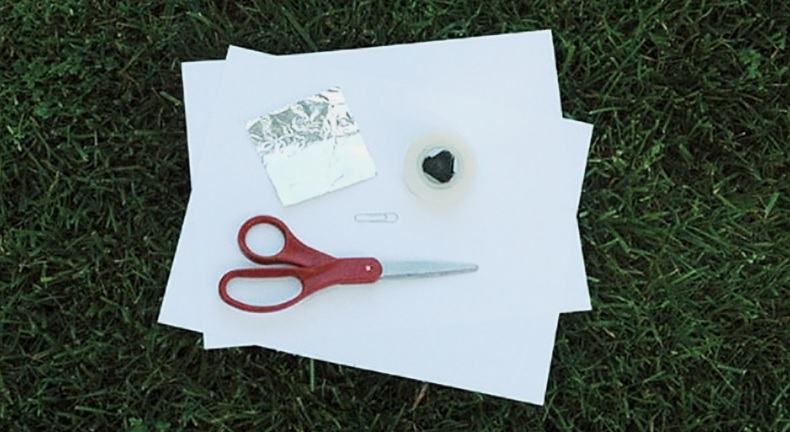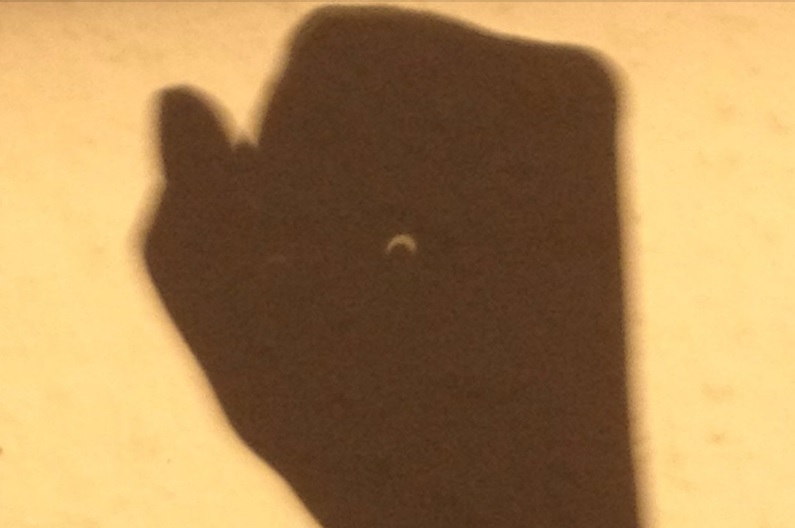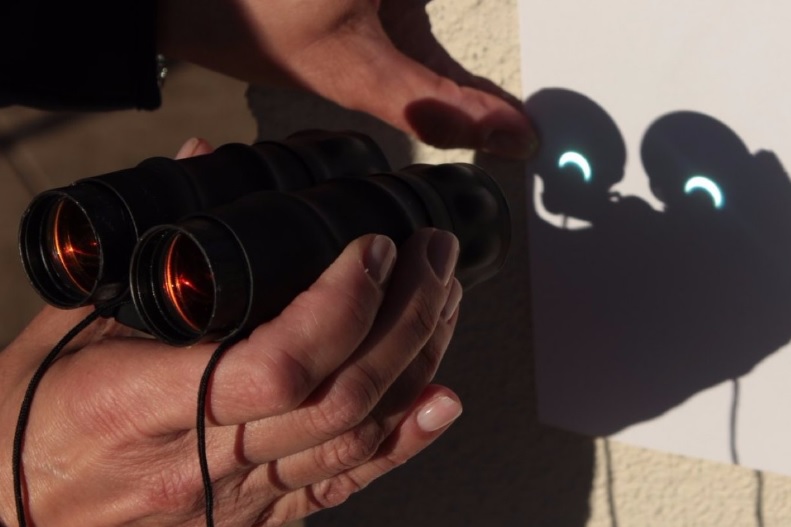On August 21, the US is getting a total solar eclipse — when the moon crosses between the Earth and the sun, blocking out the sun’s light — for the first time in decades. But only a 70-mile-wide streak of the country will see the eclipse in its totality; others will see only a partial eclipse.
A tool from the US Naval Observatory can calculate exactly how much of the upcoming solar eclipse you will see in your hometown. Enter your city, state, and approximate height at which you plan to view the eclipse. (For example, if you’ll watch it from the roof of a 10-story building, you’d put in 30 meters.)
New Yorkers will see about 71.4% of the total solar eclipse, meaning the moon will obscure most of the sun. The calculator also says that the best time to view the eclipse in New York City — which will last over 2.5 hours — will be approximately 2:45 pm ET.
Viewers in Portland, Oregon, however, will see about 99.4% of the eclipse, with the best view at 10:19 am PT (12:19 CST). This site is a best case scenario if there are few clouds in the sky.
Cloud Cover in darker colors
A word of warning for viewing the eclipse: don’t look directly at the sun. There are solar filters designed to let you see the eclipse in a way that will keep your eyes from getting damaged.
On August 21, the total solar eclipse will race across the continental US for the first time in 99 years.
Nearly anyone in the country can see the moon take a bite out of the sun during the epic event, weather permitting. Those in the path of totality can also watch the sun’s bright disk vanish.
However, it won’t be safe to look directly at the sun during the partial eclipse, as this can damage your eyes or even blind you. And that’s why online retailers are selling out of protective eclipse glasses and experiencing frustrating shipping delays.
The good news is that you don’t need special glasses to see a partial eclipse. In fact, everything you need to watch the eclipse is probably in one or two kitchen drawers or, failing that, the palm of your hand.
The trick is a pinhole camera, which exploits a property of light called diffraction to bend and magnify light. In this case, that’s the eclipsing sun.
A pinhole camera won’t let you look directly at the sun — but in some ways, that’s better, because a crowd of people can gather around your setup to watch, point at, and discuss its projected image.
Pinhole cameras can get pretty advanced with darkened boxes and tripods, but NASA’s Jet Propulsion Laboratory has instructions for an incredibly simple version that you can build in a few minutes.
Grab some scissors, tin foil, a piece of thick card stock (or paper), tape, and a needle. Cut a hole in the middle of one sheet of card stock, tape the edges of a tin foil section over it, then carefully pierce the center of the foil with the needle — presto, you’ve made a pinhole camera.
The stuff you need to make a pinhole solar-eclipse viewer. NASA/JPL-Caltech
To use your device, hover it over something white, ideally a piece of paper, and move it up and down until you figure out where the ideal focus point is. You may want to experiment with widening the hole or even using a hole punch.
Don’t have these supplies sitting around? Make a fist.
If you barely let a point of sunlight sneak through, you can diffract and project the light using a fleshly pinhole camera.
A fist-based pinhole camera shows the crescent sun, center, during an eclipse. Hat4Rain/Flickr (CC BY 2.0)
There are other, more efficient ways to use projection to your advantage, though.
One excellent method is holding binoculars up to the sun — but not pointing them at your or anyone else’s eyes — while aiming the eyepiece on something bright and white, such as paper:
Here’s how to make sure your eyes will be protected with a solar filter
First, you can buy them through a NASA-approved list.
If you were given the glasses by a friend or family member, and you’re not entirely sure where they came from, you can check to see if the glasses comply with the “ISO 12312-2” safety standard. If so, the glasses will either have that or “ISO 12312-2:2015” written on them. But, with counterfeits on the market, it’s possible that the label might not be fully accurate, according to the American Astronomy Society.
While you can’t test glasses yourself to see if the solar filters are up to that standard, you can test to see if the glasses are definitely unsafe.
“You shouldn’t be able to see anything through a safe solar filter except the sun itself or something comparably bright, such as the sun reflected in a mirror, a sun glint off shiny metal, the hot filament of an unfrosted incandescent lightbulb, a bright halogen light bulb, a bright-white LED flashlight (including the one on your smartphone), or an arc welder’s torch,” the AAS said on its website. “All such sources should appear quite dim through a solar viewer. If you can see lights of more ordinary brightness through your eclipse glasses or a handheld viewer, and you’re not sure the product came from a reputable vendor, it’s no good.” (Emphasis ours.)
You don’t need to be overly skeptical about solar eclipse glasses. If the person who gave you the glasses is an amateur or professional astronomer, the AAS said, it’s likely they’re up to the proper standards. The same goes for museums, libraries, and or astronomy clubs, the AAS said on its website.
Scammers are flooding the market with fake solar eclipse glasses.
Watching the eclipse with glasses that haven’t met certain qualifications can lead to eye damage. And, as retailers run out of eclipse glasses, some people are being duped by glasses that may look real, but that won’t protect your eyes.
“It’s a bunch of unscrupulous people cashing in on the eclipse and putting public safety at risk,” Richard Fienberg, press officer for the American Astronomical Society (AAS), told Reuters.
One easy way to check if your eclipse glasses are safe is to see if they have the ISO logo on them. If your glasses have the logo, they meet the necessary safety standards. If they don’t, then you may have been scammed.
The AAS and NASA have also published a list of legitimate companies making certifiably-safe eclipse glasses.
These are the safe eclipse glasses brands that you should be buying:
American Paper Optics (Eclipser) / EclipseGlasses.com / 3dglassesonline.com
APM Telescopes (Sunfilter Glasses)
Baader Planetarium (AstroSolar Silver/Gold Film) (The AAS notes that Baader Planetarium’s AstroSolar Safety Film and AstroSolar Photo Film is not meant to be used in an eclipse.)
Celestron (EclipSmart Glasses & Viewers)
DayStar (Solar Glasses)
Explore Scientific (Solar Eclipse Sun Catcher Glasses)
Lunt Solar Systems (SUNsafe SUNglasses), as well as kid-size eclipse glasses.
Meade Instruments (EclipseView Glasses & Viewers)
Rainbow Symphony (Eclipse Shades)
Seymour Solar (Helios Glasses)
Thousand Oaks Optical (Silver-Black Polymer & SolarLite)
TSE 17 (Solar Filter Foil)
Below, Business Insider has compiled a collection of what should be the best feeds. As new ones go live, we’ll embed or link to them — so bookmark this page for later.
NASA is pulling out all of the stops with two live feeds of the solar eclipse, via NASA TV and NASA EDGE, across multiple popular streaming-video services. We recommend watching those.
NASA’s first stream goes on-air at 8:45 a.m. PDT/10:45 a.m. Texas Time, which is about an hour before the darkest shadow of the moon, called the umbra, first touches Oregon.
From there the umbra will zoom southeast at speeds of 1,440 mph to 2,370 mph, ending its American journey 93 minutes later in South Carolina. This map shows where and when the umbra — and totality — will arrive across the US:
If you’re interested in taking a road trip or happen to be near the totality area, the National Centers for Environmental Information listed some of the major cities that will get to see a total eclipse on August 21, what time they’ll see it, and how cloudy that day has been historical.








 EastTexasRadio.com Powered by Ten Stations
EastTexasRadio.com Powered by Ten Stations





